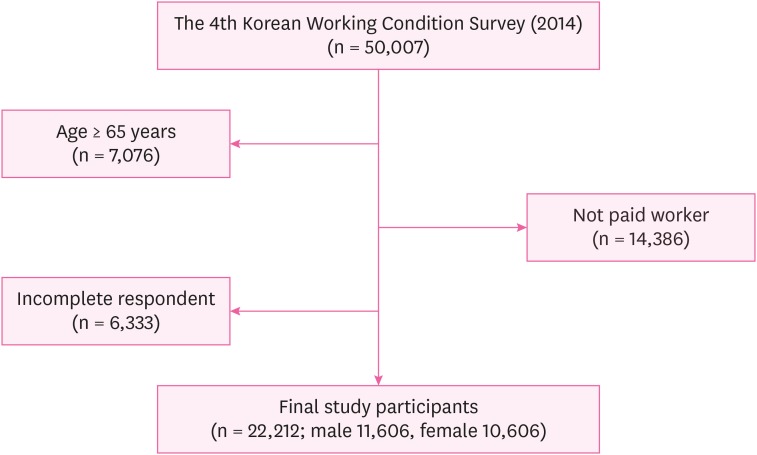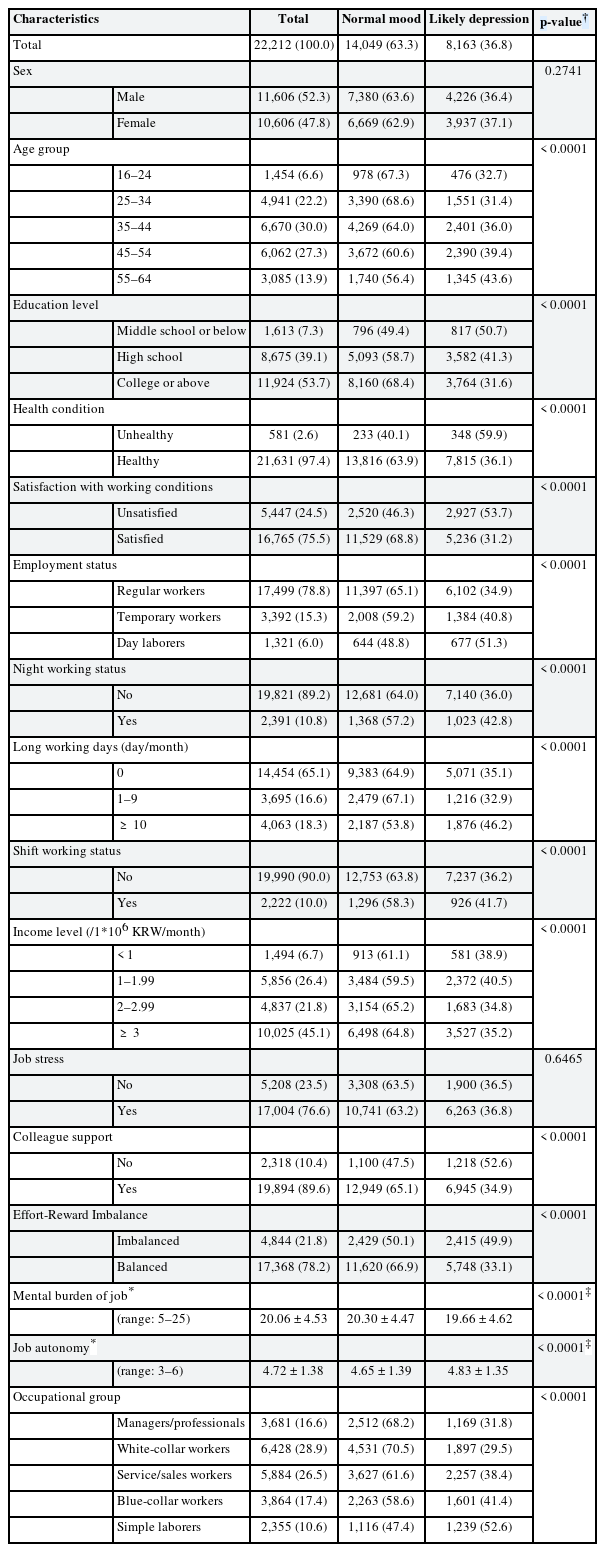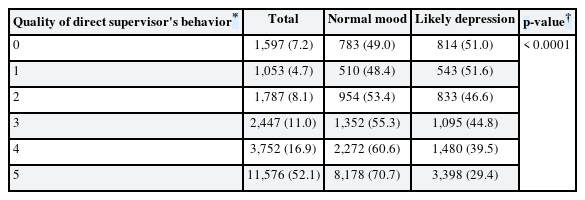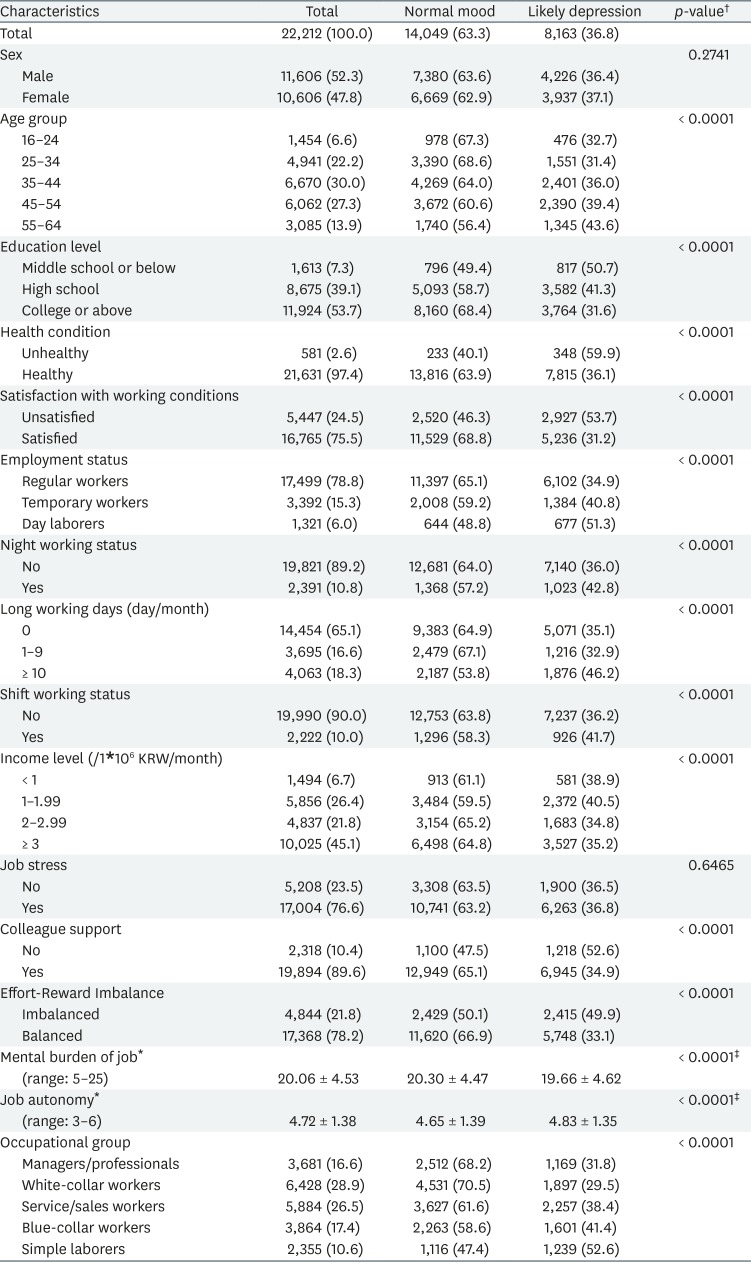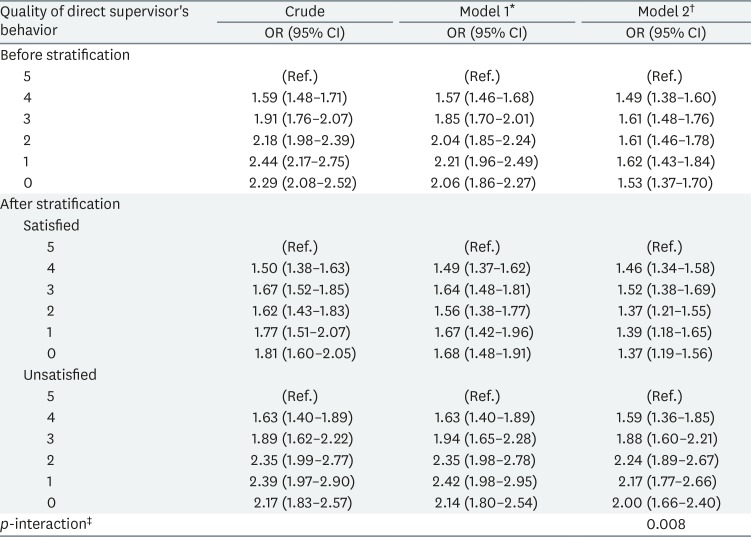The association between quality of direct supervisor's behavior and depressive mood in Korean wage workers: the 4th Korean Working Conditions Survey
Article information
Abstract
Background
Workers spend most of their social lives at work and have relationships of varying nature with people in the workplace. Direct supervisors, in particular, have a direct and lasting impact on workers, which may influence workers' mental health. Depression is very prevalent worldwide, and social concern about the disease is on the rise. The aim of this study is to investigate the effect of direct supervisors' behavior on the depressive mood of Korean wage workers.
Methods
We used data from the 4th Korean Working Conditions Survey held in 2014; 22,212 participants were included in the analysis. The quality of a direct supervisor's behavior was categorized from 0 (= lowest) to 5 (= highest) points. The degree of depressive mood was measured on a scale from “normal mood” to “likely depression” based on the 5-item World Health Organization Well-Being Index (WHO-5) questionnaire. Multiple logistic regression was used to analyze the association between the quality of the direct supervisor's behavior and the depressive mood of wage workers.
Results
After multivariable adjustment, significantly increased odds ratio (OR) for likely depression was found in the 4, 3, 2, 1, and 0 points of the quality of the direct supervisor's behavior compared to 5 points. After stratification for the level of satisfaction with working conditions, the OR of the unsatisfied groups was higher than that of the satisfied groups.
Conclusions
Likely depression was found to be significantly associated with a low quality of direct supervisor's behavior. This association was stronger in workers who were not satisfied with their working conditions. This study suggests that proper management of the direct supervisor's behavior is needed to reduce the risk of depression among Korean wage workers.
BACKGROUND
Workers in Korea spend most of their social lives at work and have various relationships with their superiors and colleagues. Direct supervisors are in a position to most directly affect the physical and mental health of their subordinate workers. In many countries, research has shown that the behavior of supervisors is associated with workers’ stress levels and sleep disturbances [12].
According to epidemiological data from the World Health Organization (WHO), depression is the third leading cause of global burden of disease and is expected to continue to increase in the future [3]. It is estimated that 1 out of 20 adults (5.3% of the total population) experience depression more than once during their lifetime, according to the Epidemiological Survey of Psychiatric Illnesses in Korea conducted in 2016 [4]. Depression is one of the most common psychiatric disorders, and is accompanied by mental, physical, and cognitive changes that affect the ability to perform daily functions due to decreased motivation and depressive mood [5]. At the workplace, depression can also lead to absenteeism or reduced productivity and increased social costs [6].
Supervisor support plays an important role in the performance and capacity development of workers [7]. In a recent study, it was reported that support from the supervisor is related to the depressive mood of the worker [8]. One study suggested that mediation of interpersonal conflict in the workplace may be effective in preventing depression in the workplace [9]. Another study reported that bullying in the workplace is associated with depression and sleep disturbances [10]. Neither study suggested a direct relationship with the supervisor. However, the supervisor can contribute to conflicts and bullying in the workplace. Indeed, in one study, workers who worked with a supervisor who acted positively were found to be mentally healthier [1]. In addition, one study reported that support from the supervisor has a protective effect on depression and stress [11]. In a study using data from the European Working Conditions Survey (EWCS), it was suggested that supervisors' behavior should be monitored constantly because it plays a non-negligible role in workers' health problems caused by psychological factors [2].
In the Korean population, a study using the second Korean Working Conditions Survey (KWCS) (2011) reported that exposure to risk factors in the workplace is associated with sleep disorders [12]. One study suggested that inappropriate relationships with supervisors or colleagues are associated with insomnia [13]. In another study of caregivers, instrumental support from supervisors was found to protect workers' depressive mood [14]. In addition, there was a report that job stress was associated with mental health problems such as depression and sleep disorders among white-collar workers [15]. In a qualitative case study of married men experiencing difficulties in their relationship with supervisors, the authors pointed out that conflict with the supervisors led to anxiety and eventually depression [16].
It is difficult to generalize these results because the study population is small or targeted for specific occupations. There is limited research on the relationship between supervisors and depression, and no study has been reported on the behavior of direct supervisors. Therefore, in this study, we investigated the effect of direct supervisors' behavior on the depressive mood of Korean wage workers.
METHODS
Participants
The KWCS has been conducted five times since 2006. In this study, we used the data from the fourth survey, which was conducted in 2014. It was supervised by the Occupational Safety & Health Research Institute and surveyed by Media Research. The survey conducted from June to August 2014 in 17 cities and provinces in Korea had the economically active population of over 15 years of age as its subjects. The purpose of the survey was to identify the overall work environment of workers and use this information as basic data for establishing industrial health and safety policies. KWCS was developed based on EWCS and the Labor Force Survey (LFS). About 50,000 households were sampled and individual one-on-one interviews were conducted.
The study sample was analyzed to ensure statistical validity and representativeness according to methods used in previous studies [1718]. The age of the study participants was set from 15 to 64 years—the age range of the working population. Soldiers and respondents whose data were incomplete were excluded; data from 22,212 participants were used for final analysis (Fig. 1).
Measurements
In this study, we identified the quality of direct supervisors' behavior as the independent variable and depressive mood as the dependent variable. Factors known to be related to independent and dependent variables as the general and occupational characteristics were used as control variables. The definition of variables is as follows.
Independent variable: the quality of a direct supervisor's behavior
To assess the direct supervisor's behavior, the independent variable in this study, we used the following question (Q58): “In general, how is your (immediate) direct supervisor in the following aspects? Please select the appropriate response for each item.” This item included 5 sub-items: i) Provides me with feedback on my work; ii) Respects me as a person; iii) Is good at resolving conflicts; iv) Is good at planning and organizing work; and v) Encourages me to participate in important decisions.
For each item, respondents answered either “Yes,” “No,” “Do not know/No answer,” or “Reject,” and only respondents who answered “Yes” or “No” were included. “Yes” and “No” were scored as 1 and 0, respectively. By adding all the scores for each of the five items, a variable with scales ranging from 0 to 5 points was obtained. This variable was defined as the quality of the direct supervisor's behavior, and the higher the value, the higher the quality of the direct supervisor's behavior. In this study, this variable was analyzed as a categorical variable, and 5 points was used as a reference. Cronbach’s alpha reliability coefficient was used to calculate the internal consistency of Q58. A reliability analysis produced Cronbach's alphas of 0.811 for the Q58.
Dependent variable: depressive mood
To assess the depressive mood, the dependent variable in this study, we used the following question (EF4): “Please indicate, for each of the five statements, which is the closest to how you have been feeling over the last two weeks.” This item included 5 sub-items: i) I have felt cheerful and in good spirits; ii) I have felt calm and relaxed; iii) I have felt active and vigorous; iv) I woke up feeling fresh and rested; and v) My daily life has been filled with things that interest me.
These questions are from the 5-item World Health Organization Well-Being Index (WHO-5) [19]. Each of the five items is scored on a 6-point Likert scale from 0 (= at no time) to 5 (= all of the time). The raw score, ranging from 0 to 25, is obtained by adding each of the five scores. Then the raw score is multiplied by 4 and converted to a number between 0–100, with higher scores meaning better well-being. Based on this score, we defined > 50 points as “normal mood” and ≤ 50 points as “likely depression.” Responses of “Do not know/No answer,” or “Reject” were excluded.
Control variables
Risk factors of major depressive disorder included: family or personal past medical history of depressive or substance-related disorders, chronic diseases, stressful events, trauma, domestic violence, being women, middle aged, having an unmarried or divorced status, a poorly paid or unemployed status, education level below high school, and physical disability [20].
The general characteristics considered in this study included sex, age, education level, and health condition. Other factors were not investigated in the KWCS data.
• Age: Age was classified into 5 groups: 15–24, 25–34, 35–44, 45–54, and 55–64 years.
• Education: Education level was categorized into the following 3 groups: middle school or below, high school, and college or above.
• Health condition: Health condition was evaluated by the question, “How is your health in general?” with 5 response options: very good, good, fair, bad, and very bad. Health condition was further classified into the following 2 groups: healthy (very good, good, or fair) and unhealthy (bad or very bad).
• Psychological factors [21] such as low job satisfaction, job stress, high mental burden of the job, low job autonomy, effort-reward imbalance, and low colleague support and work environment factors [22], such as long working hours, shift work, and night work were reported in previous studies as occupational risk factors for depression.
• Satisfaction with working conditions: Satisfaction with working conditions was evaluated by the question, “Overall, what do you think about the working conditions you work in?” with 4 response options: very satisfied, satisfied, not very satisfied, and not at all satisfied. Working condition satisfaction was classified into the following 2 groups: satisfied (very satisfied or satisfied) and unsatisfied (not very satisfied or not at all satisfied).
• Employment status: Employment status was categorized into the following 3 groups: regular workers, temporary workers, and day laborers.
• Night working status: Night working status was assessed by the question, “How many days a month do you work at night, for at least 2 hours between 10 pm and 5 am?" Night working status was categorized into the following 2 groups: yes (at least one day) and no (never).
• Long working days: Long working days was assessed by the question, “How many days a month do you work more than 10 hours a day?" Long working days was categorized into the following 3 groups: 0 (never), 1–9, and ≥ 10.
• Shift working: Shift working status was classified as yes/no according to the answer of “Do shift work,” which is a sub-question of “What is your work pattern?”
• Income level: Income level was assessed by monthly average income. Income level was classified into 4 groups: < 1, 1–1.99, 2–2.99, and ≥ 3 (/1*106 KRW/month).
• Job stress: Job stress was evaluated by the question, “Do you experience stress in your work?” with 5 response options: always, most of the time, sometimes, rarely, and never. Job stress was classified into the following 2 groups: yes (always, most of the time, or sometimes) and no (rarely or never).
• Colleague support: Colleague support was evaluated by the question, “Do your colleagues help and support you?” with 5 response options: always, most of the time, sometimes, rarely, and never. Colleague support was further classified into the following 2 groups: yes (always, most of the time, or sometimes) and no (rarely or never).
• Effort-Reward Imbalance (ERI): ERI was evaluated by the item, “I am getting adequate reward for the work I do” with 5 response options: strongly agree, agree, neither agree nor disagree, disagree, and strongly disagree. ERI was classified into the following 2 groups: balanced (strongly agree, agree, or neither agree nor disagree) and imbalanced (disagree or strongly disagree).
• Mental burden of the job: Mental burden of the job was assessed by the question, “If you make mistakes in your work, could it cause the following situation?" with 5 sub-questions: i) Physical injury to you; ii) Physical injury to others; iii) Delay work; iv) Give stress to others; and v). Financial loss to your company. Each of the 5 questions is scored on a 5-point Likert scale from 1 (= always) to 5 (= never). Scores are summated, with the continuous variable ranging from 5 to 25. Lower scores indicate higher mental burden of the job.
• Job autonomy: Job autonomy was assessed by the question, “Are you able to choose or change?" with 3 sub-questions: i) Your order of tasks; ii) Your methods of work; and iii) Your speed or rate of work. Each of the 3 questions is scored as 1 (= yes) to 2 (= no). Scores are summated, with the continuous variable ranging from 3 to 6. Lower scores indicate higher job autonomy.
• Occupational group: The 10 categories of occupational groups (managers, professionals, technicians and associated professionals, white-collar workers, service workers, sales workers, skilled agriculture, forestry and fisheries workers, craft and related trades workers, plant/machine operators and assemblers, and simple laborers) were re-categorized into 5 groups: managers/professionals, white-collar workers, service/sales workers, blue-collar workers, and simple laborers.
Statistical analysis
A χ2 test was conducted to identify the prevalence of likely depression according to general and occupational characteristics of the participants. The distribution of the quality of direct supervisors' behavior according to depressive mood was described. The odds ratio (OR) of likely depression according to the quality of direct supervisors' behavior were assessed by multiple logistic regression analysis adjusting for control variables. In Model 1, general characteristics including sex, age group, education level, and health condition were adjusted. Model 2 was further adjusted by adding occupational characteristics including working condition satisfaction, employment status, night working status, long working days, shift working status, income level, job stress, colleague support, ERI, mental burden of the job, job autonomy, and occupational groups to Model 1. Additionally, we stratified the participants by the level of satisfaction with working conditions for analysis. All analyses were performed using SAS 9.4 statistical software for Windows (SAS Inc., Cary, NC, USA).
Ethics statement
Institutional Review Board (IRB) of Seoul National University Hospital determined to exempt the review of this study and approved the waiver of written informed consent (IRB No. E-1808-061-965).
RESULTS
The general and occupational characteristics of the participants were as follows (Table 1). Of the total 22,212, 11,606 were male (52.3%) and 10,606 were female (47.8%). The mean age was 41.6 ± 11.0. Among them, 53.7% reported their education level as college or above and 2.6% reported that their health condition was unhealthy; 24.5% were not satisfied with their working conditions. The majority of the participants (78.8%) were regular workers; 10.8% reported working at night and 18.3% had a long working day of more than 10 days. The proportion of shift workers was 10.0%. The largest income level was ≥ 3 (/1*106 KRW/month; 46.0%). Further, 76.6% reported job stress, and 10.4% answered that they did not receive support from colleagues; 21.8% showed that effort and reward were imbalanced. In terms of occupational classification, white-collar workers accounted for the largest number (28.9%), followed by service/sales workers (26.5%).
The overall frequency of likely depression was 36.8% (Table 1). There was no statistically significant difference in the frequency according to sex and job stress. The frequency of likely depression was higher in workers over 55 years old, workers without high school education, unhealthy workers, those who were not satisfied with their working conditions, and day laborers. Workers with night work, long working days more than 10 days per month, shift work, income level of 1–1.99 (/1*106 KRW/month), no support from colleagues, in the imbalanced ERI group, and blue-collar workers also had a higher frequency of likely depression.
The distribution of the quality of the direct supervisor's behavior according to depressive mood is as follows (Table 2). Of the total 22,212, more than half of the workers (52.1%) rated the quality of the direct supervisor's behavior as 5 points. The frequency of likely depression was the lowest at 5 points and the highest at 2 points. Compared with the normal mood group, the frequency of 0–1 points was higher and the frequency of 2–5 points was lower in the likely depression group. There was a statistically significant difference between the two groups in the quality of direct supervisors' behavior (p-value < 0.001).
The results of the multiple logistic regression models are shown in Table 3. As compared to the highest quality of the direct supervisor's behavior (5 points), the ORs of likely depression for 4, 3, 2, 1, and 0 points were 1.59 (95% confidence interval [CI]: 1.48–1.71), 1.91 (95% CI: 1.76–2.07), 2.18, (95% CI: 1.98–2.39), 2.44 (95% CI: 2.17–2.75), and 2.29 (95% CI: 2.08–2.52), respectively, in the unadjusted model. After adjustment for sex, age group, education level, and health condition (Model 1), lower quality of the direct supervisor's behavior had a significant association with likely depression as compared to the reference group. The ORs of likely depression for 4, 3, 2, 1, and 0 points were 1.57 (95% CI: 1.46–1.68), 1.85 (95% CI: 1.70–2.01), 2.04 (95% CI: 1.85–2.24), 2.21 (95% CI: 1.96–2.49), and 2.06 (95% CI: 1.86–2.27), respectively. After adjustment for sex, age group, education level, health condition, satisfaction with working conditions (not in the stratified models), employment status, night working status, long working days, shift working status, income level, job stress, colleague support, ERI, mental burden of job, job autonomy, and occupational group (Model 2), lower quality of the direct supervisor’s behavior was significantly associated with likely depression. As compared to the reference group, the ORs of likely depression for 4, 3, 2, 1, and 0 points were 1.49 (95% CI: 1.38–1.60), 1.61 (95% CI: 1.48–1.76), 1.61 (95% CI: 1.46–1.78), 1.62 95% CI: (1.43–1.84), and 1.53 (95% CI: 1.37–1.70), respectively.

ORs for likely depression according to the quality of direct supervisor's behavior stratified by satisfaction with working conditions
In order to investigate the association between quality of the direct supervisor’s behavior and likely depression in participants with different levels of satisfaction with working conditions, stratified analyses were applied as seen in Table 3. In the unadjusted model, unsatisfied workers had higher OR for likely depression compared to satisfied workers. Similarly, in Model 1, the OR was higher in the unsatisfied workers than in the satisfied workers. After full adjustment (Model 2), the OR decreased, but there was still a higher association in the unsatisfied workers than in the satisfied workers. As compared to the reference group, the ORs of likely depression for 4, 3, 2, 1, and 0 points were 1.46 (95% CI: 1.34–1.58), 1.52 (95% CI: 1.38–1.69), 1.37 (95% CI: 1.21–1.55), 1.39 (95% CI: 1.18–1.65), and 1.37 (95% CI: 1.19–1.56), respectively, in the satisfied workers. In the unsatisfied workers, the ORs were 1.59 (95% CI: 1.36–1.85), 1.88 (95% CI: 1.60–2.21), 2.24 (95% CI: 1.89–2.67), 2.17 (95% CI: 1.77–2.66), and 2.00 (95% CI: 1.66–2.40), respectively. The ORs for likely depression according to control variables were shown in Supplementary Tables 1, 2, 3. The ORs for likely depression according to the quality of direct supervisor's behavior stratified by each control variables were shown in Supplementary Tables 4, 5, 6, 7, 8, 9, 10.
DISCUSSION
This study investigated the effect of direct supervisors' behavior on the depressive mood of wage workers in various working environments. Multiple logistic regression showed a significant association between likely depression and low quality of direct supervisor behavior. The exact mechanisms of how the quality of the direct supervisor's behavior can affect mood has not been clarified. Considering a previous study showing an association between abusive supervision and emotional exhaustion of workers [23], it can be assumed that the quality of the direct supervisor's behavior can influence psychological disorders and emotional distress [24]. Stress hormones including cortisol and norepinephrine are dysregulated with elevated stress, leading to neurotoxicity in cerebral and hippocampal areas and eventually psychiatric disorders such as depressive disorders can result [25]. Those with a medical history of mental diseases or susceptibility to psychiatric disorders respond to low quality behavior from direct supervisors more sensitively, which raises the probability of developing depressive disorders [26].
By stratifying levels of satisfaction with working conditions—a control variable that showed interaction with the quality of direct supervisor behavior (p interaction = 0.008)—we demonstrated that direct supervisor behavior may have different effects on satisfied and unsatisfied groups. Job satisfaction is correlated with various indicators of health including depressive disorders [21]. Considering that the relationship exists between quality of direct supervisor behavior and depressive mood, and that a higher OR of likely depression was seen in those unsatisfied with their working conditions, we can infer that working condition satisfaction may influence the psychological response to the direct supervisor's behavior.
This study has several limitations. First, as can be seen in Table 1, general and occupational characteristics, except sex and job stress, showed statistically significant differences between groups with different moods. Although every control variable was adjusted in the final logistic model, the possibility of bias due to these factors remains. Second, the limitations of cross-sectional studies are inherent in this study owing to its design. Though a correlation between the quality of the direct supervisor's behavior and depressive mood was shown in this study, a causal relationship cannot be inferred. Additional longitudinal studies with panels or cohorts are needed. On the other hand, the possibility of reverse causality cannot be excluded. Depressed people tend to interpret events in a distorted way of negative views of themselves, of their environment, and of things to come. They misinterpret facts in a negative way, focus only on the negative aspects of a situation, and have pessimistic and desperate expectations about the future [27]. This suggests that depressed people may have a relatively negative assessment of the behavior of direct supervisor compared to those who are not depressed. Third, effects of health-risk behaviors, such as alcohol consumption and smoking, were not considered. Such variables were excluded because the 4th KWCS did not address such issues. Though the correlation between smoking and depressive disorders was found to be low in a recent study [28], a high correlation between alcohol consumption and depressive disorders was demonstrated in numerous studies [2930]. Moreover, factors such as medical history, family history of psychiatric disorders, stressful events, trauma, domestic violence, marital status, and physical disability were also not considered. It is expected that more accurate results will be obtained if these items are added to the survey questionnaire. Fourth, the independent variable, quality of the direct supervisor's behavior, was evaluated and calculated by only five questions, the rationale of which may be debatable. The responses to each question were dichotomized and may have resulted in extreme estimations. Additionally, our study is the first to apply a scaling system ranging from 0 to 5 by adding the scores of each question, mainly because the questions used in our study were rarely used in other studies. We were, however, able to find a study applying a similar method with data from the EWCS that posed an additional question to our five questions, and measured the quality of the supervisor's behavior based on the responses on a 0–6 scale [2].
Our study is the first to investigate the relationship between direct supervisor behavior and depressive mood in Korean wage workers. While previous studies have focused on supervisors or colleagues, our study narrowed the focus to direct supervisors. We illustrated a significant correlation between direct supervisor behavior and depressive mood in workers, and with stratified analysis, we also showed that the correlation is stronger in workers who are not satisfied with their working conditions. Furthermore, this study was performed with data from a nationwide survey with a large sample size representative of Korean workers. The WHO-5, used as the dependent variable in this study, is a tool widely used to assess mental health. A systematic review of the WHO-5 shows that it has high clinical validity and is a sensitive and specific screening tool for depression [31]. In this study, we used 50 points as a cutoff for likely depression, which is presented as a criterion for clinical depression in the review. In this regard, our study has the advantage of making the assessment of depression more objective and specific by using the more reliable WHO-5 compared to existing studies, which mainly used self-report questionnaires.
Our study suggests that direct supervisor behavior can have a significant impact on workers' mental health, especially depression, and suggests that social awareness needs to be addressed and concrete action plans should be sought. To this end, further research based on more specific evaluation of direct supervisor behavior and continued interest in addressing workers' mental health issues are needed.
CONCLUSIONS
A low quality of direct supervisor behavior was significantly associated with likely depression in Korean workers. To our knowledge, this is the first study demonstrating the association between quality of direct supervisor's behavior and depressive mood in a representative sample of Korean wage workers. The association was prominent in workers who were not satisfied with their working conditions. This finding suggests that proper management of direct supervisor behavior is needed to reduce the risk of depression among Korean wage workers.
ACKNOWLEDGEMENTS
Authors appreciate Occupational Safety and Health Research Institute (OSHRI) for offering raw-data of KWCS (Korean Working Conditions Survey).
Notes
Competing interests: The authors declare that they have no competing interests.
Author Contributions:
Conceptualization: Park CJ, Yook JH.
Data curation: Park CJ, Yook JH.
Formal analysis: Park CJ, Yook JH, Kim MS, Lee D, Lim HM, Hong YC.
Investigation: Park CJ, Yook JH, Kim MS, Lee D, Lim HM, Hong YC.
Writing - original draft: Park CJ.
Writing - review & editing: Hong YC.
Abbreviations
CI
confidence interval
ERI
Effort-Reward Imbalance
EWCS
European Working Conditions Survey
KWCS
Korean Working Conditions Survey
LFS
Labor Force Survey
OR
odds ratio
WHO
World Health Organization
WHO-5
5-item World Health Organization Well-Being Index
References
SUPPLEMENTARY MATERIALS
Supplementary Table 1
ORs for likely depression according to the quality of direct supervisor's behavior and control variables
Supplementary Table 2
ORs for likely depression according to the quality of direct supervisor's behavior and control variables stratified by satisfaction with working conditions (satisfied)
Supplementary Table 3
ORs for likely depression according to the quality of direct supervisor's behavior and control variables stratified by satisfaction with working conditions (unsatisfied)
Supplementary Table 4
ORs for likely depression according to the quality of direct supervisor's behavior stratified by age group
Supplementary Table 5
ORs for likely depression according to the quality of direct supervisor's behavior stratified by education level
Supplementary Table 6
ORs for likely depression according to the quality of direct supervisor's behavior stratified by night working status
Supplementary Table 7
ORs for likely depression according to the quality of direct supervisor's behavior stratified by long working days (day/month)
Supplementary Table 8
ORs for likely depression according to the quality of direct supervisor's behavior stratified by income level (/1*106 KRW/month)
Supplementary Table 9
ORs for likely depression according to the quality of direct supervisor's behavior stratified by colleague support
Supplementary Table 10
ORs for likely depression according to the quality of direct supervisor’s behavior stratified by occupational group

